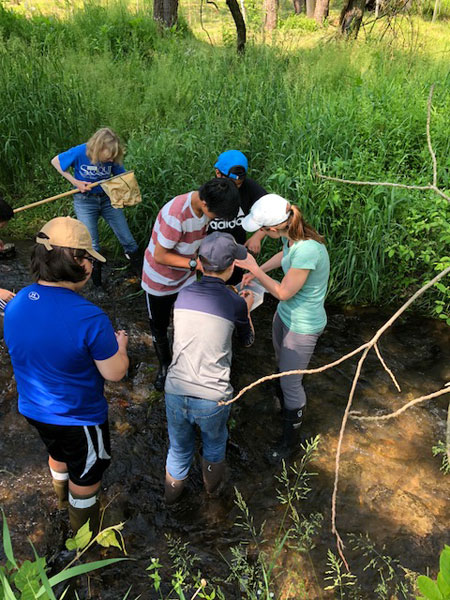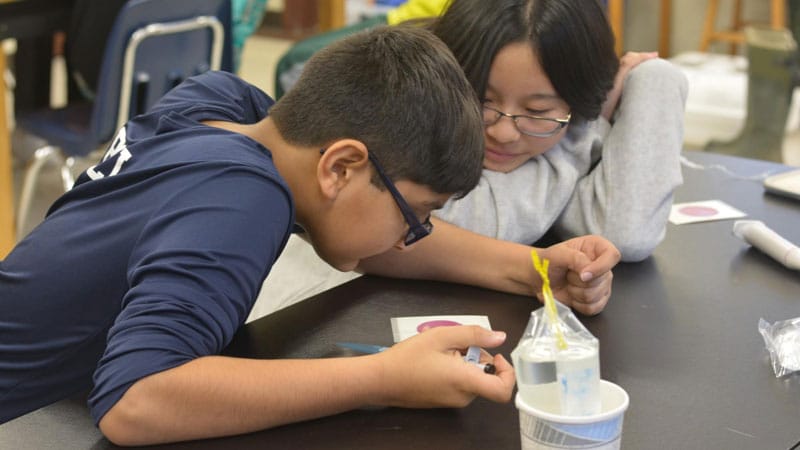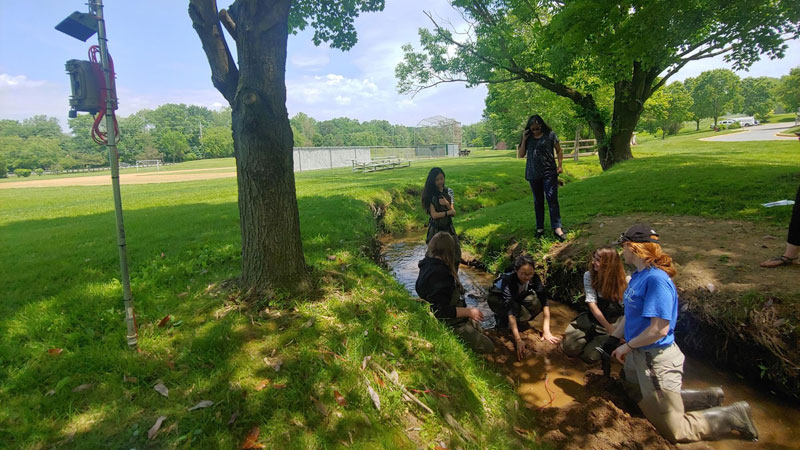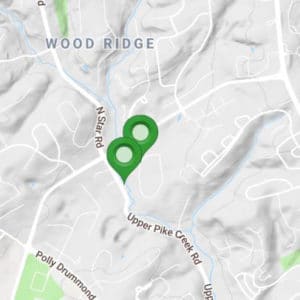By David Bressler, Sarah Ferrell, and Tara Muenz

The seed of a new STEM (science, technology, education, and mathematics) education partnership was planted in 2017 when Rachel Wood, a former educator and grandmother of a sixth-grader at The Independence School in Newark, Delaware, suggested that the school collaborate with Stroud Water Research Center.
“I’ve always found it quite remarkable that an internationally renowned water research center would be so committed to educating students about freshwater systems. Once I realized that Pike Creek flowed through the school’s property, I felt a partnership with the Stroud Center could provide the guidance needed for teachers and students to study and explore the characteristics of the stream and better understand watersheds,” said Wood.
She added, “The partnership also synced perfectly with efforts by the administration to expand outdoor education and to use the school property as a living laboratory with unique learning opportunities.”
Exploring Their Campus Stream
Over the last two years, the Stroud Center and The Independence School have conducted a variety of in-class and field activities. For an E. coli monitoring lesson, the Stroud Center provided equipment and instruction on microbial testing that Independence students could do on water from a small stream running through the school’s campus. The students learned lab practices such as pipetting and plating water samples, identifying and counting bacterial colonies, and determining if water was safe for human contact.

Upcoming classes will introduce the Leaf Pack Network®, an international network of teachers, students, and citizen monitors investigating their local stream ecosystems. The students will assemble bags of native leaves and place them in the campus stream for a few weeks to be colonized by macroinvertebrates. They will then remove the bags from the stream and count and identify the macroinvertebrates. They will be able to rank the stream’s water quality and determine its overall health based on the numbers and kinds of macroinvertebrates they find.
Young Citizen Scientists
Stroud Center staff including David Bressler, Shannon Hicks, and Rachel Johnson, worked with The Independence School science teachers Sarah Ferrell and Jessie Copeland in installing and managing two EnviroDIY™ sensor stations in streams on the school’s campus. The sensors measure conductivity, temperature, and water depth and transmit data in real time to a website that students can access from their computers.
Stroud Center educator David Kline taught the students how to interpret the data from their sensor stations and showed how different sized storms affected the streams. During the winter, students observed large “spikes” in conductivity and after some questioning and thinking, they discovered the elevated readings were due to road salts flushing into the stream after the melting of snow and ice.
Stroud Center staff introduced the students to Model My Watershed®, one of several online tools in the WikiWatershed® toolkit, which allowed them to evaluate how land-use changes are tied to the ecological observations they were making about their school’s streams.

Ferrell has been instrumental in integrating Stroud Center resources into The Independence School science curriculum and has seen a positive change in her students’ understanding of science: “Through our connection to the Stroud Center this year, our students have been transformed into active citizen scientists. They’ve learned not only how to make contributions to a global community of researchers and scientists but have been empowered by sharing their own data with the world. I have noticed an increase in our students’ ability to analyze and interpret graphs as well as an enhanced awareness of their impact on freshwater ecosystems.”
So that other educators can be inspired to build similar partnerships that advance environmental education, Ferrell and Tara Muenz, the Stroud Center’s assistant director of education, gave a 45-minute presentation on the sensor station collaboration at the 2019 Delaware Environmental Education Association’s annual conference in Newark, Delaware.
Collaboration Provides Opportunities for Growth
This collaborative endeavor has provided both the Stroud Center and The Independence School with new opportunities for growth and development of their educational and citizen science capacities and resources.
Bernadette Gilmore, director of academics and curriculum at The Independence School stated, “We have been delighted to work with the Stroud Center. Through our connection with them, we have expanded students’ knowledge of freshwater systems and have utilized our own campus more fully for science research and learning.”
This collaboration between The Independence School and the Stroud Center has not only been fruitful in its own right but is serving as a template for opportunities with other schools and has been a useful pilot study for testing lesson plans and unconventional learning opportunities. The data collected on campus is feeding into the William Penn Foundation’s Delaware River Watershed Initiative, a collaborative watershed research, restoration, and protection effort among over 50 nonprofit groups, schools, and universities across the Delaware Basin.
You can view real-time data from The Independence School’s sensor stations on MonitorMyWatershed.org. Type the school name in the “Organizations” search box and then click on a site marker. Monitor My Watershed® is part of WikiWatershed, an initiative of Stroud Water Research Center designed to help citizens, conservation practitioners, municipal decision-makers, researchers, educators, and students advance knowledge and stewardship of fresh water.
Explore the WikiWatershed Toolkit
More information and links to the individual tools can be found at WikiWatershed.org.
- Model My Watershed lets you analyze geospatial data, model storms, and compare conservation or development scenarios in a watershed.
- Runoff Simulation shows how land use and soil together determine whether rainfall infiltrates into the soil, runs off into streams, or is evaporated and transpired by plants.
- EnviroDIY is a community of do-it-yourself enthusiasts sharing open-source ideas for environmental science and monitoring.
- Leaf Pack Network is an international network of teachers, students, and citizen monitors investigating their local stream ecosystems.
- The Water Quality Mobile App records water-monitoring data and enhances learning activities for students and citizen scientists. Available for Apple and Android devices.




